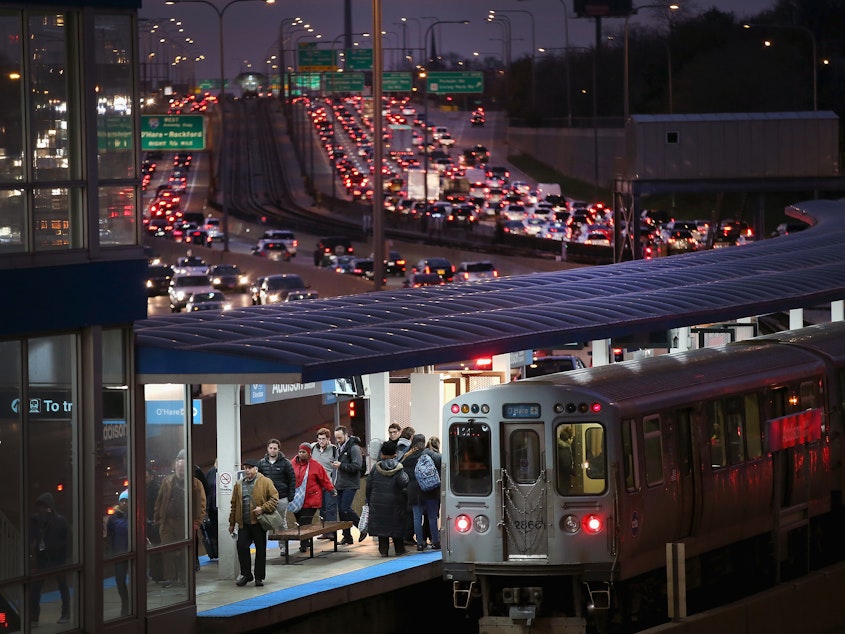Unwanted Sides Of Rain, Cold And Snow Could Complicate Thanksgiving Travel

This Thanksgiving, bitter — possibly record — cold could be served up alongside slices of turkey in the eastern U.S., while snow the day before could complicate travel on one of the busiest travel days of the year.
Farther west, rain in the forecast could be disastrous for a region already devastated by wildfires.
A cold front moving through the Northeast on Wednesday was spreading some light snow in New England and the northern mid-Atlantic, said David Roth, forecaster with the National Weather Service's Weather Prediction Center.
"It really doesn't take all that much to become a problem on the roadways," Roth tells NPR.
And when commuters and holiday travelers clog the roads even in fair weather, major cities can see up to a four-fold increase in traffic on the day before Thanksgiving, said AAA Public Relations Director Jeanette Casselano.
As motorists are sitting in traffic, at least they can think about how gas is several cents cheaper on average than last week, according to AAA. That puts it about on par with last Thanksgiving's average.
Nationally, the average price of a gallon of regular gas is $2.60 as of Wednesday. Fueling up is priciest in Hawaii, at about $3.82 a gallon, followed by California at $3.63. You can find the cheapest gas in Missouri, at $2.24 a gallon, according to AAA, followed by Delaware at $2.27.
From Wednesday through the weekend, AAA predicts more than 54 million people in the U.S. will travel 50 miles or more — a 4.8 percent rise over last year and the highest number of travelers since 2005. The vast majority will be on the roadways, while around 4 million will fly, AAA forecasts.
Airlines for America, an industry trade association, says that a record 30.6 million passengers will travel on U.S. airlines during a 12-day Thanksgiving air travel period. That's up from last year's estimated 29 million passengers. The group said cheaper airfare is contributing to the increase.
If you're heading to the airport, NPR's Karen Grigsby Bates points out that the Transportation Security Administration is cool with passengers cramming holiday turkeys and pumpkin pies in their carry-ons, provided they're within size requirements. "Those items are considered solid. Spreadable foods like mashed potatoes and cranberry sauce, though, are limited to the standard 3.4 ounces for all liquid items," she says.
Bottles of wine can go in checked luggage.
Sunday is projected to be the busiest day to fly, with more than 3 million people taking to the air.
About a million-and-a-half passengers will take trains, buses and cruise ships over the long holiday weekend, according to AAA, an increase of 1.4 percent over last year.
"Higher wages, more disposable income and rising levels of household wealth," mean more people venturing forth this holiday, according to Bill Sutherland, senior vice president at AAA Travel.
Some of that extra income might go toward boosting the thermostat on Thanksgiving, when significant cold — "possibly [up to] 40 degrees below normal" — is predicted in parts of the Northeast, Roth said.
Highs are forecast to reach only around 21 degrees in Boston, 25 degrees in New York City and 29 degrees in Philadelphia on Thursday.
"I mean it's November ... that's more December, January, February" weather, Roth said. "In some areas it might end up being record cold so early."
But the weather should be warming up just as people are doing the same with their Thanksgiving leftovers. By Sunday in Boston, highs should hover around 50, Roth said, "so it gets more seasonable."
Snow is in the Thanksgiving Day forecast for parts of the Midwest, Roth said, while rain will be the major factor Wednesday into Thursday in the West.
That could spell trouble for wildfire-ravaged parts of California. Much of the northern part of the state is under a flash-flood watch through Friday morning. Debris flows could be a particular threat for areas scarred by wildfire, where the land has been stripped bare.
"Really, any rainfall would be a problem in those areas," Roth said.
Higher elevation areas in Northern California's Plumas County and the northern Sierra Nevada could see snow, with accumulations topping 1 foot. The National Weather Service is advising people there to stay put, but if travel is a must, it says to "keep an extra flashlight, food and water in your vehicle in case of an emergency." [Copyright 2018 NPR]

